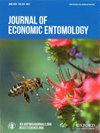Evaluation of winter cover crop methods for management of flatheaded appletree borer (Coleoptera: Buprestidae).
IF 2.4
2区 农林科学
Q1 ENTOMOLOGY
引用次数: 0
Abstract
Winter cover crops grown at the base of red maples (Acer rubrum L.) can reduce flatheaded appletree borer (Chrysobothris femorata Olivier; Coleoptera: Buprestidae; FAB) damage by both physically blocking preferred oviposition sites and altering the environment around them. However, cover crop competition negatively affects tree growth. To investigate long-term cover crop effects, trees grown with cover crop for 2 yr were transitioned to a standard herbicide practice. After 4 yr, trees in the initial 2 yr cover crop plots were 1 yr behind in growth compared to trees grown in bare rows for all 4 yr. Most growth reduction occurred in the first year following transplant. Additional borer losses of 1–2% per year were observed in production years 3 and 4. A second experiment answered 2 questions: Can killing the cover crop once it reaches maximal height protect trees from borers while also reducing competition and thereby increase tree growth? and Do herbicide applications increase borer attacks? In this experiment, red maples were grown with (i) a standard herbicide program, (ii) a mulch mat, (iii) a cover crop that was killed early, or (iv) a cover crop allowed to senesce naturally. Evaluations after 2 yr indicated early kill of the cover crop was not enough to improve tree growth. Further, trees in the early kill cover crop treatment had the most FAB attacks. Cover crops allowed to senesce naturally reduced FAB attacks in both studies; however, more work is needed to minimize disparities in tree growth during the initial year post-transplant and determine the causal relationship between herbicide use and borer attacks.苹果扁螟冬季覆盖作物管理方法评价。
在红枫(Acer rubrum L.)基部生长的冬季覆盖作物可以减少苹果扁头螟(Chrysobothris femorata Olivier);鞘翅目:吉丁虫科;通过物理阻断首选产卵地点和改变周围环境来破坏FAB)。然而,覆盖作物竞争对树木生长有负面影响。为了研究覆盖作物的长期影响,用覆盖作物种植2年的树木过渡到标准除草剂做法。4年后,在最初的2年覆盖作物地块上生长的树木比在光秃秃的行中生长的树木慢1年。大部分生长减少发生在移植后的第一年。在生产第3年和第4年观察到每年额外损失1-2%的蛀虫。第二个实验回答了两个问题:一旦覆盖作物达到最高高度,杀死它们是否可以保护树木免受蛀虫的侵害,同时减少竞争,从而促进树木生长?除草剂的使用会增加螟虫的袭击吗?在这个实验中,红枫生长在(i)标准除草剂程序,(ii)覆盖物垫,(iii)覆盖作物被提前杀死,或(iv)覆盖作物允许自然衰老。2年后的评价表明,早期杀死覆盖作物不足以改善树木生长。此外,早杀覆盖作物处理的树木有最多的FAB攻击。在两项研究中,被允许衰老的覆盖作物自然地减少了FAB的攻击;然而,需要做更多的工作,以尽量减少移植后第一年树木生长的差异,并确定除草剂使用与蛀虫发作之间的因果关系。
本文章由计算机程序翻译,如有差异,请以英文原文为准。
求助全文
约1分钟内获得全文
求助全文
来源期刊
CiteScore
4.60
自引率
9.10%
发文量
198
审稿时长
3-6 weeks
期刊介绍:
Journal of Economic Entomology the most-cited entomological journal – publishes articles on the economic significance of insects and other arthropods and includes sections on apiculture & social insects, insecticides, biological control, household & structural insects, crop protection, forest entomology, and more. In addition to research papers, Journal of Economic Entomology publishes Reviews, interpretive articles in a Forum section, Short Communications, and Letters to the Editor. The journal is published bimonthly in February, April, June, August, October, and December.

 求助内容:
求助内容: 应助结果提醒方式:
应助结果提醒方式:


